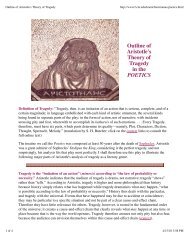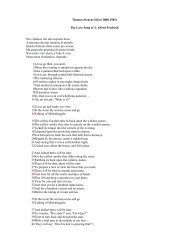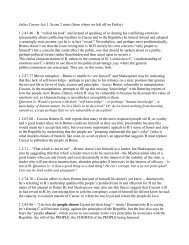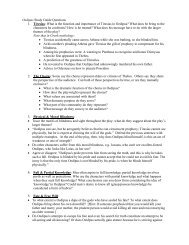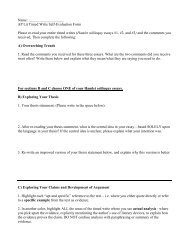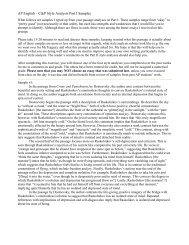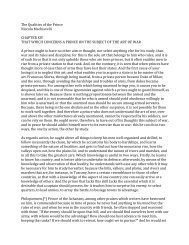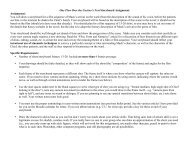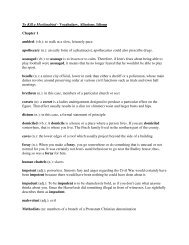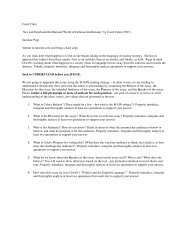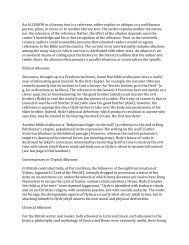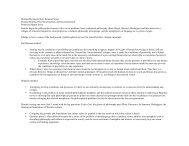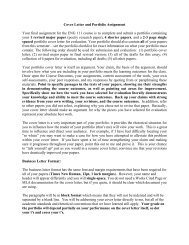Ending the Essay: Conclusions So much is at ... - Whs.babienko.net
Ending the Essay: Conclusions So much is at ... - Whs.babienko.net
Ending the Essay: Conclusions So much is at ... - Whs.babienko.net
Create successful ePaper yourself
Turn your PDF publications into a flip-book with our unique Google optimized e-Paper software.
<strong>Ending</strong> <strong>the</strong> <strong>Essay</strong>: <strong>Conclusions</strong><br />
<strong>So</strong> <strong>much</strong> <strong>is</strong> <strong>at</strong> stake in writing a conclusion. Th<strong>is</strong> <strong>is</strong>, after all, your last chance to persuade your readers<br />
to your point of view, to impress yourself upon <strong>the</strong>m as a writer and thinker. And <strong>the</strong> impression you<br />
cre<strong>at</strong>e in your conclusion will shape <strong>the</strong> impression th<strong>at</strong> stays with your readers after <strong>the</strong>y've fin<strong>is</strong>hed<br />
<strong>the</strong> essay.<br />
The end of an essay should <strong>the</strong>refore convey a sense of completeness and closure as well as a sense of<br />
<strong>the</strong> lingering possibilities of <strong>the</strong> topic, its larger meaning, its implic<strong>at</strong>ions: <strong>the</strong> final paragraph should<br />
close <strong>the</strong> d<strong>is</strong>cussion without closing it off.<br />
To establ<strong>is</strong>h a sense of closure, you might do one or more of <strong>the</strong> following:<br />
• Conclude by linking <strong>the</strong> last paragraph to <strong>the</strong> first, perhaps by reiter<strong>at</strong>ing a word or phrase you<br />
used <strong>at</strong> <strong>the</strong> beginning.<br />
• Conclude with a sentence composed mainly of one-syllable words. Simple language can help<br />
cre<strong>at</strong>e an effect of underst<strong>at</strong>ed drama.<br />
• Conclude with a sentence th<strong>at</strong>'s compound or parallel in structure; such sentences can establ<strong>is</strong>h<br />
a sense of balance or order th<strong>at</strong> may feel just right <strong>at</strong> <strong>the</strong> end of a complex d<strong>is</strong>cussion.<br />
To close <strong>the</strong> d<strong>is</strong>cussion without closing it off, you might do one or more of <strong>the</strong> following:<br />
• Conclude with a quot<strong>at</strong>ion from or reference to a primary or secondary source, one th<strong>at</strong><br />
amplifies your main point or puts it in a different perspective. A quot<strong>at</strong>ion from, say, <strong>the</strong> novel<br />
or poem you're writing about can add texture and specificity to your d<strong>is</strong>cussion; a critic or<br />
scholar can help confirm or complic<strong>at</strong>e your final point.<br />
For example, you might conclude an essay on <strong>the</strong> idea of home in James Joyce's short story<br />
collection, Dubliners, with inform<strong>at</strong>ion about Joyce's own complex feelings towards Dublin,<br />
h<strong>is</strong> home. Or you might end with a biographer's st<strong>at</strong>ement about Joyce's <strong>at</strong>titude toward Dublin,<br />
which could illumin<strong>at</strong>e h<strong>is</strong> characters' responses to <strong>the</strong> city. Just be cautious, especially about<br />
using secondary m<strong>at</strong>erial: make sure th<strong>at</strong> you get <strong>the</strong> last word.<br />
• Conclude by setting your d<strong>is</strong>cussion into a different, perhaps larger, context. For example, you<br />
might end an essay on ni<strong>net</strong>eenth-century muckraking journal<strong>is</strong>m by linking it to a current<br />
newsmagazine program like 60 Minutes.<br />
• Conclude by redefining one of <strong>the</strong> key terms of your argument.<br />
For example, an essay on Marx's tre<strong>at</strong>ment of <strong>the</strong> conflict between wage labor and capital<br />
might begin with Marx's claim th<strong>at</strong> <strong>the</strong> "capital<strong>is</strong>t economy <strong>is</strong> . . . a gigantic enterpr<strong>is</strong>e of<br />
dehumaniz<strong>at</strong>ion"; <strong>the</strong> essay might end by suggesting th<strong>at</strong> Marx<strong>is</strong>t analys<strong>is</strong> <strong>is</strong> itself<br />
dehumanizing because it construes everything in economic ra<strong>the</strong>r than moral or ethical terms.<br />
• Conclude by considering <strong>the</strong> implic<strong>at</strong>ions of your argument (or analys<strong>is</strong> or d<strong>is</strong>cussion).<br />
Wh<strong>at</strong> does your argument imply, or involve, or suggest? For example, an essay on <strong>the</strong> novel<br />
Ambiguous Adventure, by <strong>the</strong> Senegalese writer Cheikh Hamidou Kane, might open with <strong>the</strong><br />
idea th<strong>at</strong> <strong>the</strong> protagon<strong>is</strong>t's development suggests Kane's belief in <strong>the</strong> need to integr<strong>at</strong>e Western
m<strong>at</strong>erial<strong>is</strong>m and Sufi spirituality in modern Senegal. The conclusion might make <strong>the</strong> new but<br />
rel<strong>at</strong>ed point th<strong>at</strong> <strong>the</strong> novel on <strong>the</strong> whole suggests th<strong>at</strong> such an integr<strong>at</strong>ion <strong>is</strong> (or <strong>is</strong>n't) possible.<br />
Finally, some advice on how not to end an essay:<br />
• Don't simply summarize your essay. A brief summary of your argument may be useful,<br />
especially if your essay <strong>is</strong> long - more than ten pages or so. But shorter essays tend not to<br />
require a rest<strong>at</strong>ement of your main ideas.<br />
• Avoid phrases like "in conclusion," "to conclude," "in summary," and "to sum up." These<br />
phrases can be useful - even welcome - in oral present<strong>at</strong>ions. But readers can see, by <strong>the</strong> telltale<br />
compression of <strong>the</strong> pages, when an essay <strong>is</strong> about to end. You'll irrit<strong>at</strong>e your audience if<br />
you belabor <strong>the</strong> obvious.<br />
• Res<strong>is</strong>t <strong>the</strong> urge to apologize. If you've immersed yourself in your subject, you now know a<br />
good deal more about it than you can possibly include in a five- or ten- or 20-page essay. As a<br />
result, by <strong>the</strong> time you've fin<strong>is</strong>hed writing, you may be having some doubts about wh<strong>at</strong> you've<br />
produced. (And if you haven't immersed yourself in your subject, you may be feeling even<br />
more doubtful about your essay as you approach <strong>the</strong> conclusion.) Repress those doubts. Don't<br />
undercut your authority by saying things like, "th<strong>is</strong> <strong>is</strong> just one approach to <strong>the</strong> subject; <strong>the</strong>re<br />
may be o<strong>the</strong>r, better approaches. . ."<br />
Copyright 1998, P<strong>at</strong> Bellanca, for <strong>the</strong> Writing Center <strong>at</strong> Harvard University<br />
From Learnhub.com:<br />
Conclusion: Here are some suggestions:<br />
• Answer <strong>the</strong> question “<strong>So</strong> Wh<strong>at</strong>?”<br />
Show your readers why th<strong>is</strong> paper was important. Show <strong>the</strong>m th<strong>at</strong> your paper was meaningful and<br />
useful.<br />
• Syn<strong>the</strong>size, don’t summarize<br />
Don’t simply repe<strong>at</strong> things th<strong>at</strong> were in your paper. They have read it. Show <strong>the</strong>m how <strong>the</strong> points you<br />
made and <strong>the</strong> support and examples you used were not random, but fit toge<strong>the</strong>r.<br />
• Redirect your readers<br />
Give your reader something to think about, perhaps a way to use your paper in <strong>the</strong> “real” world. If your<br />
introduction went from general to specific, make your conclusion go from specific to general. Think<br />
globally.<br />
• Cre<strong>at</strong>e a new meaning<br />
You don’t have to give new inform<strong>at</strong>ion to cre<strong>at</strong>e a new meaning. By demonstr<strong>at</strong>ing how your ideas<br />
work toge<strong>the</strong>r, you can cre<strong>at</strong>e a new picture. Often <strong>the</strong> sum of <strong>the</strong> paper <strong>is</strong> worth more than its parts.<br />
© 2008 Savvica, All Rights Reserved




